Sound
I’m going to step through the generic switches all the way up to the LS OCXO.
Starting with the TRENDnet TEG-S8g and S50g, I thought they sounded pretty good. Nice tonality, punchy, clear, and a decent amount of body. Both have a little bit of grain in the mids but overall very musical. The S50g is the quieter of the two and had more clarity and focus. Bass is a tiny bit boomy for both but not terrible. At this point I was pretty happy with these unmodified switches.
Moving to the Cisco and we have something really special. It’s much more liquid over the TRENDnets with more palpable textures and coherence. Bass is tighter with less overhang, decent outlines on singers and instruments, and overall just more shape and gradations. The TRENDnets have a more golden tone which I prefer but for all intents and purposes, it’s a great switch for a smoother listening experience. Cisco’s obviously using higher-grade parts in this switch.
Now with the SOtM’s D-Link (clocked by the tX-USBultra), the tonality is cooler than that of the Cisco. It’s much smoother than the TRENDnets and provides more body and musical shape over the Cisco. Transients are also incisive and clear. Overall a very silky and a slightly softer presentation over the other switches. The Cisco switch does gets pretty close as far as performance.
Now we’re at The Linear Solution OCXO switch. At this point, I’m expect minimal improvements at best. The generics didn’t really sound that bad at all. Perhaps a little rougher and thinner, but still enjoyable.
Well…
Once I plugged the TLS OCXO switch in – I realized just how much of an impact an audiophile switch could make in a system. It is a huge step in fidelity. It has all the qualities of the other switches – and more. Almost like the Captain Marvel of ethernet switches. It’s quiet, warmblooded, articulate, resolving, dynamic, and offers up the perfect amount of vibrancy. You stop thinking about the technical improvements and just allow the music to envelop you. Tactility from percussions and strings are imparted with finesse and candor while voices are rich and detailed. Imaging and layering of the soundstage is leagues better than the generics as well. It has the right amount of color, transparency, dynamism, and overall clarity.
I’m not sure what else to say. It is the best sounding switch I’ve heard so far.
As far as the Reference CAT7 cable, they’re voiced in the same way. In comparison to my reference ethernet cable, the SOtM dCBL-CAT7, it’s denser and warmer. Given the qualities of the OCXO switch, there’s also a predictable level of musicality. Keep in mind that although they’re not labeled as directional, I did hear differences depending on orientation. I just add tape to one end to differentiate (you could see the tape in the photo).
The dCBL-CAT7 is still quieter and more resolving but when combined with a SOtM iSO-CAT6…it’s a combination that’s tough to beat. At only $198/m, this ethernet cable is one of the best values out there. I’ve since replaced the SOtM black cable with the TLS Reference.
My current chain:
Router -> LS CAT7 -> iSO-CAT6 -> dCBL-CAT7 -> LS OCXO swtich -> dCBL-CAT7 -> Innuos Zenith SE Mk.2 music server
All in all, very impressive products by The Linear Solution.
Final Thoughts
The Linear Solution has some amazing ears at the helm of their designs. Unlike the trend of creating more “hyper-real” components that impresses (and eventually fatigues), The Linear Solution knows what’s most important – musicality. Surprisingly, it still imparts an eerie level of resolution and air. It also give you more meat on the bones, truer timbre, emotional textures, and enough slam to get your feet moving. Top it off with accurate timing of reverb tails and all those organic nuances – and it’s audio heaven.
After listening to the OCXO Audiophile Switch, it’s too difficult to go back to plugging directly into generic routers or switches. You’ve already realized how much you’re missing. It’s too late.
I don’t look at The Linear Solution OCXO audiophile switch as simply a modified switch. They’ve obviously maximized what they could out of the stock components and created something else entirely. It is one thoughtful and serious piece of gear.
It’s very difficult to imagine how much better a switch could sound. Even with the advent of “super switches” such as the SOtM sNH-10G and UpTone Audio EtherREGEN, I’d be surprised if it’s that much better. But…the current audio landscape is full of surprises – so until then, I’m not letting go of this switch. 🙂
The Linear Solution no longer offers bundles so you’re free to cherry pick what you’d like.
- TLS Reference Ethernet cable
- $198/M addition meter $50
- TLS LPS
- $450.
- $750 for the Reference
- TLS OCXO Audiophile Switch
- $589

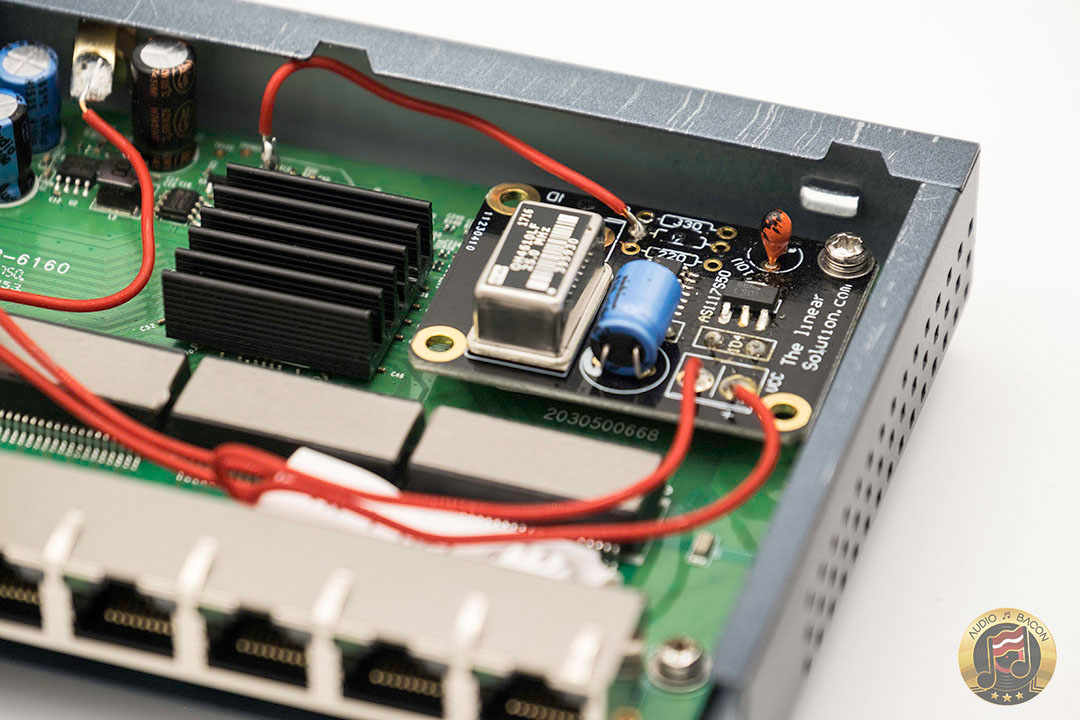

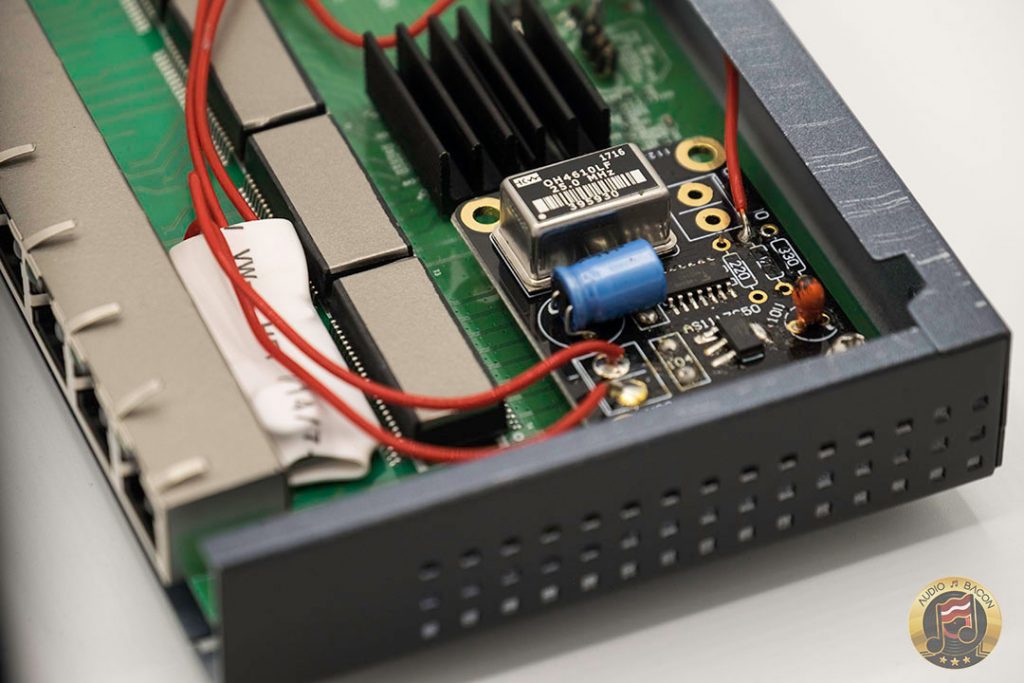
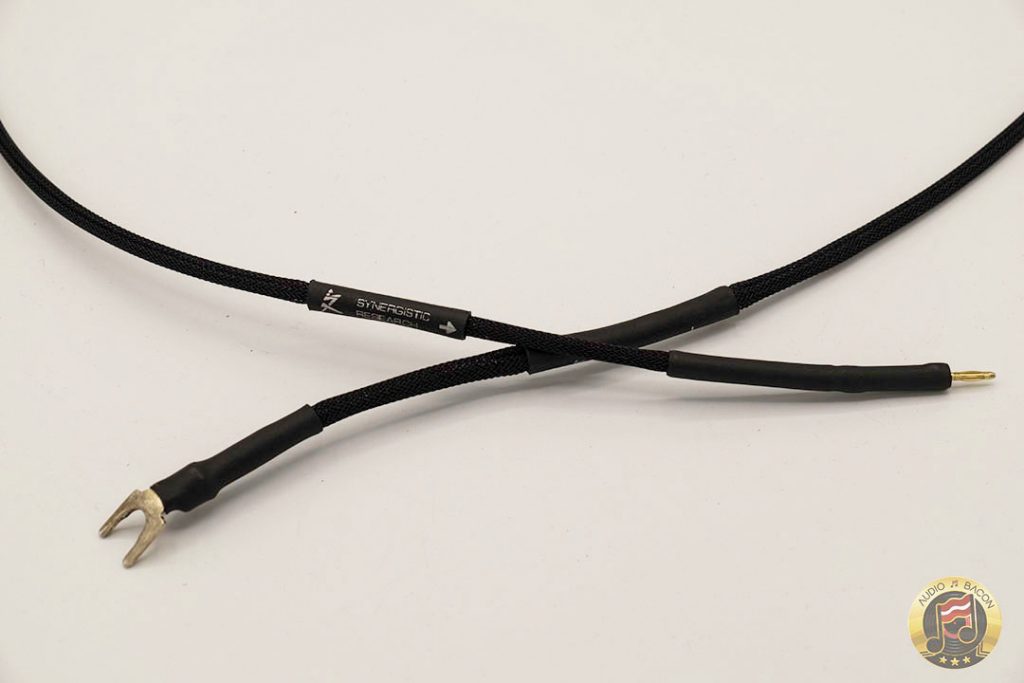

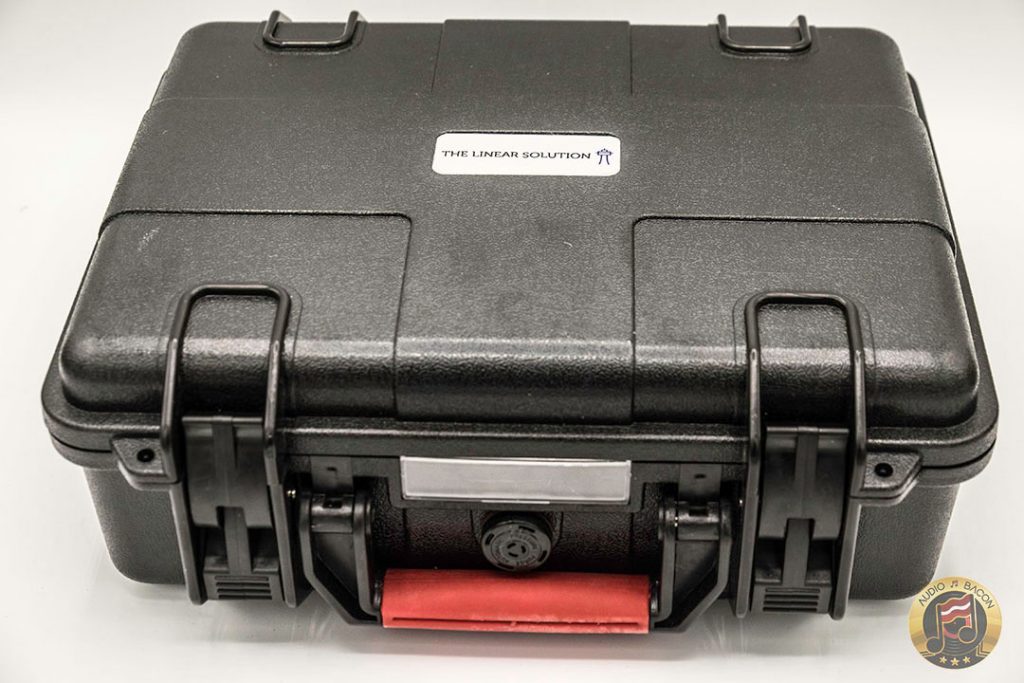



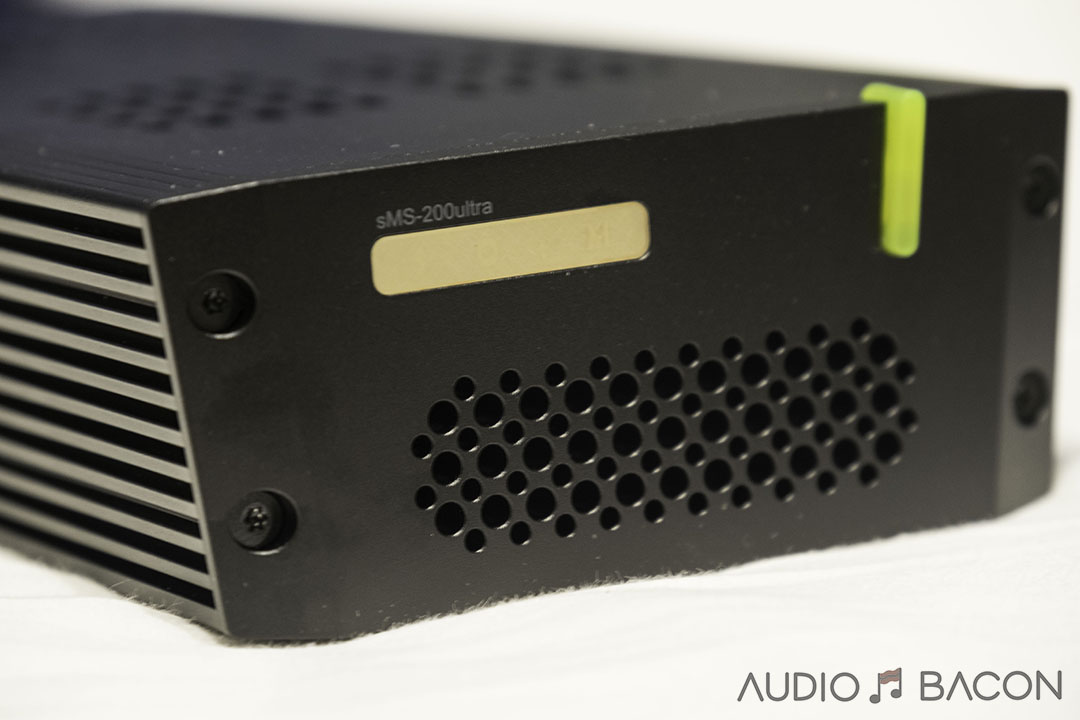
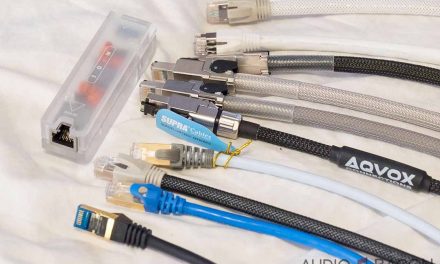



While I do not doubt that the clock quality can have an effect on sound quality of the Ethernet distribution, I am going to be very hesitant in accepting this as a good place to spend this kind of money. Priorities are important here, putting a better clock than the audio clocks in the DAC in an Ethernet switch is not defensible in terms of priorities.
The audiophile should first get clocks this good in the DAC where they make the most difference.
Additionally, is the clock signal being carried on that unshielded wire from the clock board to the main board? If so there is no way that clock signal is good, and this is poor implementation. Clock signals must be carried on impedance controlled coaxial cables, with proper impedance matched terminations at both ends (micro BNC or SMB, etc).
I have seen a lot of folks, with rather pedestrian DACs, spending lots of additional monies on Ethernet tweaks, while many of these tweaks can make a difference, the performance improvement is small compared to better speakers, a better DAC, or better masterclock(s) internally in the DAC. Please folks, get your priorities straight, work from the speakers backwards in terms of upgrades, especially when it comes to Ethernet tweaks. Bog stock Ethernet cables, switches, and routers already offer performance better than the best disc spinning transports. Only when the rest of the system is “perfect” is it time to embark on Ethernet tweaks for the last 0.5% of improvement (given that one is using a really good Ethernet Renderer).
I can’t agree more with this comment. There are several reasons that explain the fixation on small gadgets, but at the end they become expensive.
I would like that Jay makes the following test:
Laptop->stock USB cable -> DAC-> great monitors such as Paradigm Persona B (two BE drivers)
Laptop-> modded router -> Streamer-> luxury USB cable -> sotm TX-USB ultra +LPSU+reclocker -> DAC -> ATC SCM7
The first option is simpler and probably cheaper. My guess is that it produces better sound.
Having experimented with a lot of equipment, I would say:
1. Get the best DAC you can afford. Metrum Adagio NOS for me.
2. Get a superb 75 Ohm BNC
3. I use Empirical Audio Clock connected by the BNC.
4. Use good vibration control on your streamer – Grand Prix Audio feet
5. Ethernet cables – Tera Grand Cat 7 ($20 US) is exceptionally good. I have high end cables as well but these are my current preference!
6. Good Cisco Switch (opens up the soundstage dramatically versus direct connection)
7. EMO from Germany LAN Isolator
I think the “system” needs to be viewed end to end. Optimise the source as much as possible as you wont get that signal back downstream. Equally, use best power cables you can afford, then speaker cables and then IC.
Stock USB and direct to USB in DAC has not worked well for me. I think the Syncromesh clock from Empirical Audio is the most important in my system. But, the changes to the Ethernet side of things makes a very big difference and there the switch has the most compelling uplift in SQ.
Simple is not in my experience the best. It is managing each part of the chain .
COMMENT
I agree with the digital BNC cable being up there in priorities.
However, a truly superb digital BNC cable is going to cost a lot of money.
Which most people aren’t willing to spend. But it’s an absolute necessity.
Once you hear a reference digital cable, there is no going back.
I’ve been looking into Cisco switches. There is a compact switch with pOE (power over ethernet) for use powering a camera or other devise. Model: WS-C2960CX-8PC-L.
It has an IEC inlet in the back for a power cord. This may or may not be more convenient than an external power supply.
Do you have any experience with this type for audio streaming ?
That guess is already a fail. Your stock unshielded USB cable kills a major portion of the improvement the DAC and monitors might provide in electrical feedback.
This isn’t rocket science any piece of copper that has a connection to electricity will create noise in the sound stage unless it’s specifically shielding the power pin. At least put a Jitterbug on that USB connection from the laptop. It’s funny how “audiophiles” will pay hundreds to thousands of dollars for hardware and then cheap out on USB & ethernet cables.
I’m not talking about crazy money ether. $60 for a Jitterbug and $30 to $70 on a audio grade USB cable for a marked improvement. That’s pocket change in this hobby.
Before you ask I am a Electrical & Network Eng with a background in touchy copper/fiber to switches/routers/industrial machines.
I found the Lessloss USB filter gives an improvement across the audible range, whereas the Jitterbug did very little and had a slight negative effect in some ranges. There is quite a price difference, so I would definitely seek out an excellent sounding USB cable first.
Hello, Mr. Bacon. I read this review with interest, since I’m about to convert from a CD system to a streaming system. For the streaming newbie, there’s a lot to figure out.
— You do not mention that there is a TLS TCXO switch as well, slightly cheaper than the OCXO. What’s the difference?
— There is also a TLS Audio Supreme Server, price on request.
— On the TLS OCXO page, the Linear Power Supply is described. Does the switch require a power supply? You don’t discuss that. The TLS price list shows 3 LPSs priced from $459 to $899, in addition to the OCXO price of $589.
— Do you really have 3 different Ethernet cables linked in sequence between router and the OCXO? That’s what your “current chain” indicates. Talk about tweaking! If you have 20 different cables on hand, how many combinations of 3 are there to try?
Anyway, your reviews are great, and you provide info and insight that is pretty much not available anywhere else. You simply tell what you hear in specific situations. The switch matters. It’s up to us to take it from there. Why some people feel the need to tell us what our “priorities” should be, I don’t know. If you have a cheap switch, your system will not sound its best. Unfortunately, the same applies to every piece of the system. We’ve all got an existing system, a future vision, a list of wants, a budget, priorities, a room, a wife, etc. So good luck to all.
“Hello, Mr. Bacon. I read this review with interest, since I’m about to convert from a CD system to a streaming system. For the streaming newbie, there’s a lot to figure out.”
Isn’t that the truth; I’m in the same boat. I have a Streamer and am waiting on the EtherREGEN to be released (but for this discussion it will still just act as a “real good” switch). Trying to decide on (electrostatics vs planer magnetics???) headphones and the an amplifier to power same. You don’t say anything about modems. Will just any old modem do – my previous experience tells me that if a switch makes a difference, so should a modem.
(Kind of like, if your turntable is no good, it doesn’t much matter how many thousands of $$ of equipment you have downstream.) My question is: Is a good (sounding) modem all I need? Where can I get one? Connect the (audiophile-quality) modem (a simple affair – no wireless capability) to the EtherREGEN and the EtherREGEN to the Streamer with two high-quality 1-meter Ethernet cables? Job done?
How about the wireless router – can I get my iPad to communicate with the streamer without having the wireless router directly in the Ethernet chain. Can I go from Modem to EtherREGEN (or switch) to Streamer, with the wireless router off to the “side” (so, its signal comes from the EtherREGEN or the audiophile-quality switch, BUT it doesn’t have to be inserted (thereby degrading the signal) directly between the modem and the EtherREGEN or switch)? Will the iPad talk to the Streamer if the wireless unit is positioned in this fashion/location in the chain (out of the “music” signal chain)? HELP?
David, he has an isolator with an ethernet cable on either side, between the router and TCXO switch The isolator is a box about 4 inches long, 1″ x 1 1/2 “cross section. This gives a degree of isolation from the router.
Hi David,
TXCO is the clocking technology that is simpler in implementation but the performance isn’t going to be as good, but will also be cheaper. It’ll still be better than standard clock that is in a regular switch.
Yes, we’ve discussed the server with Adrian, and it sounds like it’ll be really something special. Servers are incredibly complicated and there’s still a ton of experimentation and learning.
And that leads to power supplies – the TLS swich doesn’t come with a power supply. You can probably grab a wallwort and it’ll physically work, but we’ve found the quality of the LPS is HUGELY important in the performance of the overall device. See this piece we wrote here about LPS’es:
https://audiobacon.net/2018/06/29/linear-power-supplies-for-audiophiles-getting-closer-to-live/
Also check out the write up on Ethernet cables here:
https://audiobacon.net/2017/07/09/sotm-iso-cat6-special-edition-the-flavors-of-audiophile-ethernet/
We appreciate your note, and thank you for the feedback! Cheers to your system too!
Ethernet packets are check-summed from the source. If they don’t arrive in tact, then the packet is re-transmitted. Many confuse ethernet with the anomalies of SPDIF, which it is not. Your device buffers the packets and then streams them. If you use a decent 1G switch with CAT6, then you will have all the bandwidth need to stream ANY stream. Most devices are 100Mb ethernet anyway. This is simply pseudo-science.
Hey Elmer, not only is it pseudoscience, it’s pure snake oil as well! It’s funny reading the comments from these audiophools.
But you know the old saying: “A fool and his money are soon parted”. The audiophool industry relies on idiots who believe this crap–it wouldn’t exist otherwise.
Why are people hearing a difference with these modified switches ? Is it like some of the plug in power conditioners ? Some of these create a “field” around the components, others have shunt circuits, etc.
Have you compared the linear solution ocxo switch to the Aqvox SE switch?
Hi Jay – so, as of July 2019, what is your current chain to your Innuos music server?
To? hm, just the SOtM switch, dCBL-CAT7s, iSO-CAT6, LS ethernet cable, and Snake River Audio Signature Cottonmouth power cord.
Sorry to not have been more specific. I currently am configuring a digital feed from a wall fed Coax port jack to an Innuos Zenith 2. My plans are to use a dCBL-Cat7 and SupraCable Cat8 cable with IsoCat6 switch midstream. Your thoughts and current recommendations?
Clock implementation with single wire for clock signal is terrible….
A digital switch and a digital cable improving my audio? I haven’t laughed so much in years
My advise is don’t buy one. Your laughing may stop.
Work great but the company is complete crap if still in business. It took 4 months between my order and delivery. Had it 6 months, broke down under warranty, Adrian had it for 8 months, no more answers. Do not even have a phone number. Worst company ever, do not buy from him.
Sorry to hear that. I’ll have to confirm they’re still in business before recommending them any further.
Sad. The first commenter, Barrows pointed out the use of the wrong wire from internal clock.
Most modifiers of equipment are hobbyists, and do not run a full business. My experience with several in the last 15 yeas has been poor, except for one. Try to buy from a company that makes the complete unit and has specs and honest warrantee.
That whole business is interesting, seen from the professionnal side of video and audio, where we actually use the network switches as the clock source for video/audio transport networks (Look at PTP V1,PTP V2, GPTP), as totally funky 50-100 dollar switches are sold as marvels. The fact is that PTP jitter is something important, but you really have to screw it to get audible results (AB test), and that big blades like Arista or Mellanox are really good as PTP Grandmasters, but it is only applicable if the network is part of the clocking, the audio part are just packets thrown as fast as possible in an asynchronous way and what is really important is the synchronous reconstruction of the audio stream out of the Rx buffer and the path to the AD. The best switch in terms of jitter (they even measure the jitter of SFP’s 🙂 ) is the white rabbit switch (Developed for astronomical purposes). So keep using whatever for funky audio consumer protocols. About cables : What is important is no packet loss, and that’s why any usable switch has mechanisms to measure packet loss on its ports and queue management to avoid losing packets, even under heavy load. What is important in cables is the impedance at carrier frequency, and cables are optimized for the transport on a certain distance of 100M, 1G, 10G, that’s why there are categories, and its all floating symmetrical transport. Shielding can be a problem and ground loops can occur in a very bad designed system/building.
buhahaha good stuff for 0IQ tomato head